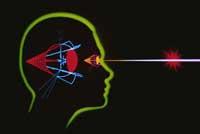The eyes of the blind also ‘see’
2001/05/21 Galarraga Aiestaran, Ana - Elhuyar Zientzia
According to Russel Foster, a neuroscientist at the Imperial School of Medicine in London, this pigment is sensitive to light, so blind mice are also able to distinguish day and night and retain functions and behaviors related to light level, such as circadian rhythm or eating hours.

The results obtained by other researchers also confirm this perception. In fact, if only the detection of luminosity changes depended on the cones and canes of the retina, a ray that breaks the darkness of the night would be enough to restore the body clock.
Foster has done his work with genetically modified mice without cones or canes and demonstrated that they retain certain behavioral models, supposedly dependent on the visual system.
The scientist of the same university, Robert Lucas, has used the same mice to analyze the mechanism of this system not related to vision. After verifying that by effect of bright light the pupils of blind mice decreased, he studied at what wavelength they were most sensitive. He observed that it showed the highest sensitivity at 479 nm, that is, at a wavelength very different from the sensitivity shown by cones and canes.
This pigment has been called OP 479 and has been detected in other mammals. If you know how it works by light, steps can be taken to help patients who cannot control their biological clock. In fact, clarity influences the mood and behavior of human beings. For example, high brightness in workshops increases productivity.

Gai honi buruzko eduki gehiago
Elhuyarrek garatutako teknologia



